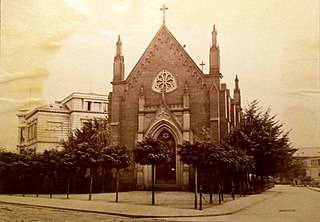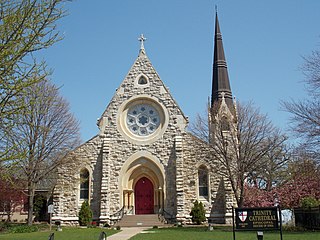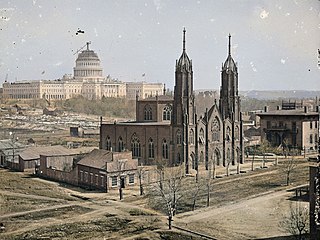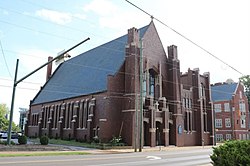
The Episcopal Diocese of Tennessee is the diocese of the Episcopal Church in the United States of America that covers roughly Middle Tennessee. A single diocese spanned the entire state until 1982, when the Episcopal Diocese of West Tennessee was created; the Diocese of Tennessee was again split in 1985 when the Episcopal Diocese of East Tennessee was formed. It is headquartered in Nashville, Tennessee.

The Cathedral Church of Saint Matthew, known simply as St. Matthew's Cathedral, is an Episcopal cathedral church located at 5100 Ross Avenue in Dallas, Texas, in the United States.

The Church of St Augustine of Canterbury, commonly known as The English church at Wiesbaden, is a Hessian heritage-listed Anglican parish church located at Frankfurter Strasse 3 in Wiesbaden, Germany. Built in 1865 and named in honour of St Augustine of Canterbury, it was designed in the Gothic Revival style by city engineer Theodor Goetz. The church remains historically, socially, and architecturally significant.

The Church of the Ascension and Saint Agnes is an Episcopal church building located at 1215 Massachusetts Avenue in Northwest Washington, D.C., US. The current structure built in 1874 as the Church of the Ascension was added to the National Register of Historic Places in 1984. In the late 1940s, the Church of the Ascension merged with the nearby St. Agnes Episcopal Church and adopted its present name, under which it has continued as an active parish in the Episcopal Diocese of Washington.

St. Mary's Episcopal Cathedral, designed by Memphis architect Bayard Snowden Cairns, located near downtown Memphis, Tennessee, is the cathedral church of the Episcopal Diocese of West Tennessee and the former cathedral of the old statewide Episcopal Diocese of Tennessee.

Christ Episcopal Church is an Episcopal congregation in South Pittsburg, Tennessee, part of the Episcopal Diocese of East Tennessee. The church building and parish house, located at 302 West 3rd Street, are listed on the National Register of Historic Places.

Christ Church Cathedral is the cathedral for the Episcopal Diocese of Indianapolis. Christ Church parish was formally organized in 1837. The present-day church building was erected in 1857 on Monument Circle at the center of downtown Indianapolis to replace the parish's first church built on the same site. Designed by architect William Tinsley, the English Gothic Revival-style structure is the oldest church building in Indianapolis and Marion County, Indiana, that has remained in continuous use. It is also the oldest building on Monument Circle. Christ Church is known for its music, especially its pipe organs, one of which was donated by Ruth Lilly, and its professional Choir of Men and Boys and Girls' Choir. The parish is also known for its community service, including an annual strawberry festival fundraiser and other charitable work. Christ Church Cathedral was added to the National Register of Historic Places on July 10, 1973. It is located in the Washington Street-Monument Circle Historic District.

St. James' Episcopal Church, named for James the Greater, is a historic Episcopal church located in Manitowoc, Wisconsin. The only Episcopal church in Manitowoc County, St. James' is a "broad church" parish in the Diocese of Fond du Lac. It is the oldest continually operating congregation in Manitowoc County, first meeting in 1841. and organizing in 1848. The current church building, an example of Gothic Revival architecture, was consecrated in 1902. The congregation is active in community service and social justice ministries.

The Church of the Good Shepherd is a historic Episcopal church in downtown Raleigh, North Carolina. The congregation branched off of Christ Episcopal Church in 1874, making it the second oldest Episcopal parish in Raleigh. It is part of the Episcopal Diocese of North Carolina and served as the Pro-cathedral church of the diocese in the mid-1890s.

The Christ Church Chapel is a religious building located at 61 Grosse Pointe Blvd. in Grosse Pointe Farms, Michigan. It is also known as the Christ Church Grosse Pointe or the Christ Episcopal Church. It was designated a Michigan State Historic Site in 1992 and listed on the National Register of Historic Places in 1993.

Trinity Episcopal Cathedral, formerly known as Grace Cathedral, is the historic cathedral in the Diocese of Iowa. The cathedral is located on the bluff overlooking Downtown Davenport, Iowa, United States. Completed in 1873, Trinity is one of the oldest cathedrals in the Episcopal Church in the United States. It was individually listed on the National Register of Historic Places in 1974. In 1983 the cathedral was included as a contributing property in the College Square Historic District, which is also listed on the National Register.

Grace Church or Grace Episcopal Church is a historic Episcopal church located at 600 Cleveland Avenue in Plainfield, Union County, New Jersey, United States. It was added to the National Register of Historic Places on May 10, 2002, for its significance in architecture, art, and music from 1892 to 1930.

St Luke's Church is a United Reformed church in the Silverhill suburb of Hastings, a town and borough in East Sussex, England. The congregation was originally independent before taking up Presbyterianism, and worshipped in a private house from its founding in 1853 until a permanent church was provided in 1857; this was one of the oldest Presbyterian places of worship in southeast England. The growth of the community has resulted in several extensions since then, and severe damage caused by the Great Storm of 1987 was quickly repaired—except for the loss of the building's distinctive spire. The church, along with most other Presbyterian congregations, joined the United Reformed Church when that denomination was formed in 1972. It is one of four United Reformed Churches in the borough of Hastings.

St. Paul's Episcopal Church in Chattanooga, Tennessee, is a downtown congregation of the Episcopal Church. It is one of the largest congregations in the Episcopal Diocese of East Tennessee.
St. James Episcopal Church is an Episcopal church in Greeneville, Tennessee, United States.
St. Peter Church, is a Catholic parish church in Cleveland, Ohio and part of the Diocese of Cleveland. Founded in 1853, it is located at the intersection of Superior Ave. near East 17th St., in the Downtown neighborhood.

The Molyneux Asylum for Blind Females was opened June 1, 1815 in Peter Street, Dublin, in what was formerly the residence of Thomas Molyneux (1641-1733), whose sister-in-law, Lucy Domville, had been blind. The building had been sold to Philip Astley, operating as Astley's Amphitheatre from 1789 to 1812, then the actor Henry Johnstone, intended to develop it as a theatre, however it reverted back to the Molyneux and was leased to a charity as an asylum for blind women. There was an Anglican church attached to the asylum. Music was an important part of the school and worship in the chapel. R.W. Beaty was an organist and music instructor from 1824. Henry Charles Shellard was organist and choirmaster from 1901 to 1955. The chapel was called the Albert Chapel, honoring the Queen's Husband.

Trinity Episcopal Church was an Episcopal church that stood from 1851 to 1936 on the northeast corner of 3rd and C Streets NW in the Judiciary Square neighborhood of Washington, D.C.

Meade Memorial Episcopal Church is a predominantly Black Episcopal Church in Old Town Alexandria, Virginia. Founded in 1870, the church today is supported by a congregation that includes descendants of the original founders of this parish. Meade Memorial belongs to the Episcopal Diocese of Virginia, whose members continue to serve the community and the Episcopal Church by participating in regional and Diocesan activities.



















